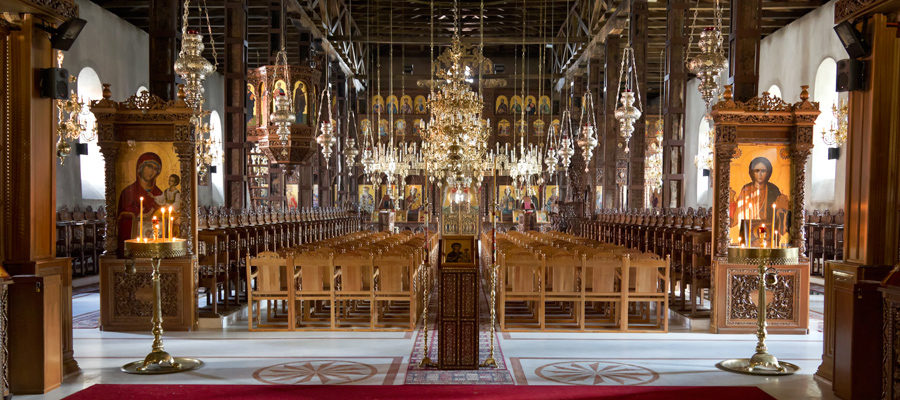Temple of St. Stefen
Something unique happens in Arnaia and is related to the holy Metropolitan church of St. Stephen. It is the only church in Greece, that operates normally, serving the needs of the pilgrims, and at the same time is built over important antiquities of priceless historical value, that are visible in their most part. I.e. besides a place of worship it is a place of historical and archaeological interest. But lets take things from the start.
This church, according to an inscripted marble plate emnedded on the wall of its facade, was built in 1812 and honors the memory of St. Stephen, since there was a dependency of the Konstamonitou monastery of Mount Athos, the Catholicon of which is also dedicated to St. Stephen. The temple is a three-aisled basilica with dimensions 41x19,5m. It was burnt from the ground up during the 1821 Revolution, as the whole village did. The residents scattered in the nearby area and returned later in order to rebuild the village and the church, in which they placed a wooden chancel and one of the few in the area wood-carved ornate despotic throne. The one of a kind chancel was a donation from the Konstamonitou monastery and included 70 smaller wooden pictures and 14 silver-coated, larger ones.
THE GREAT FIRE
On the night of September 5 of 2005, a great fire broke inside the temple and almost totaly destroyed it. The cause of the fire remains unknown. It is a fact that the fire left only the stone made walls behind. The roof collapsed, and everything inside the temple -such as pictures, books, several artifacts, objects of priceless historical and artistic value, the one of a kind, silver-gold coated wooden chancel, the wood-carved, ornate despotic throne-, turned into ashes. At once, the Ministry of Culture started the huge restoration, via the 10th Ephorate of Byzantine Antiquities, to the jurisdiction of which the temple belongs, with the cooperation of religious and local authorities, and the full support of the residents of Arnaia and the wider area.
ARCHAEOLOGICAL FINDINGS
The evidence of three older buildings was found during reconstruction and renovation of the building: a large three-aisled Christian basilica dated around 400, a small, one space byzantine temple of the 10th-11th century and a large rectangular post-byzantine structure without a niche of the 16th-17th century. At the same time, many findings, from the christian era until the Ottoman rule period, saw the light of day (objects made of clay, marble, glass and metal, plasters and murals).
Apart from these, fifteen tombs were discovered, some of which are dated in the christian era, whereas others are dated in the 16th century B.C. Thus, an important part of the area’s history was discovered due to the recostruction of the burnt building and thanks to the systematic excavations of the 10th Ephorate of Byzantine Antiquities. A historical part that shows the uninterrupted human presence and activity in Arnaia, and specificaly where the temple of St. Stephen exists today.
The protection and maintanance of the findings was next, after the completion of the renovation. At the same time, the archaeological site was configured in order to highlight the buried history of the place. The floor of the renovated temple was made of transparent panels, over which the visitor can stand or walk, while observing the enlightened archaeological site and the findings beneath it.
Info
-In 2009, when the work of the 10th Ephorate of Byzantine Antiquities was complete, the uniqueness and the highlighting of the findings resulted in the arrival of large number of visitors of every age and nationality, on daily basis. Visitors arrive alone or in groups, contributing to the touristic development of Arnaia and its wider area.
-The temple of St. Stephen of Arnaia is open for the public every day, from the morning until the afternoon.






